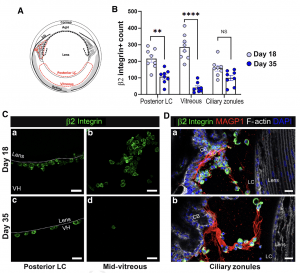The eye’s unique immune privilege, characterized by its low vascularity and restricted entry of inflammatory cells, is essential for maintaining visual function. However, this raises questions about how the eye manages inflammation when it occurs. A recent study has provided valuable insights into this process, particularly in the context of autoimmune uveitis (Figure 1).

Figure 1: Immune cells continue to associate with the posterior lens capsule and along the ciliary zonules during resolution of experimental autoimmune
uveitis (EAU). Whole eye cryosections at day 18 (D18) and D35 after induction of EAU were immunolabeled and imaged by confocal microscopy. A: Model of the regions of the eye in which images were acquired, denoted by a red dashed line. B: Quantification of CD18/b2 integrinþ leukocytes associated with the
posterior lens capsule, the vitreous, and the ciliary zonule fibrils at D18 and D35 after induction of EAU. C: Confocal microscopy images of CD18/b2 integrin-labeled immune cells (green) along the posterior lens capsule (Ca,c) and mid-vitreous (Cb,d). Ca,c: The white dotted line delineates the superficial surface of
the lens capsule. D: Confocal microscopy images of CD18/b2 integrin-labeled immune cells (green) along ciliary zonule fibrils (MAGP1 Q19; red), colabeled for F-actin (white) and nuclei (DAPI; blue). C and D: Images are single optical planes (C) and 2.5-mm projections (D). Images shown are representative of at least three independent studies. **P < 0.01; ****P < 0.0001. Scale bars Z 20 mm (C and D). AqH, aqueous humor; CB, ciliary body; LC, lens capsule; NS, nonsignificant; VH, vitreous humor.
Previous work demonstrated the presence of immune cells on the lens surface in response to injury or inflammation. This finding raised questions about their role in ongoing surveillance and inflammation resolution. The current study reveals that macrophages with an immunoregulatory phenotype and regulatory T cells (Tregs) are actively recruited to the lens during inflammation. These cells play a crucial role in restoring balance and reducing inflammation, and they persist on the lens surface until the inflammatory process is resolved.
This discovery challenges the notion of the eye being incapable of self-care. Understanding these mechanisms is essential for developing effective treatments for uveitis and other inflammatory eye conditions. Future research will focus on identifying the specific mechanisms that recruit immune cells to the lens and the early warning systems that trigger immunoregulatory inflammation.
Journal article: Phuong M. L. et al, 2024. Immunoregulatory Properties of Immune Cells that Associate with the Lens Capsule Surface during Acute and Resolution Phases of Experimental Autoimmune Uveitis, The American Journal of Pathology.
Summary by Stefan Botha










